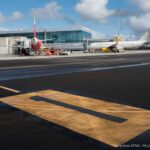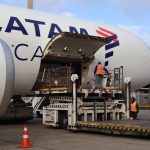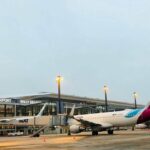Indian low-cost carrier IndiGo unveiled an innovative solution for its passenger disembarkation process. The method, named by the company as a «three-point disembarkation system», will streamline the procedure and improve operational efficiency and punctuality of services.
In this way, the company will become the first operator to use three doors to complete disembarkation. Two front exit doors (one on each side of the aircraft) and one rear exit door will be enabled.
The main novelty of the procedure lies in the use, for the first time in commercial air operations, of an exit on the right side of the aircraft for passenger disembarkation. Due to industry safety regulations, both boarding and disembarkation are carried out through the accesses located on the left side of the aircraft.
Meanwhile, ground staff tasks such as stowing and unstuffing baggage, loading fuel or boarding in remote positions for people requiring mobility assistance, remain on the right-hand side.
This is why IndiGo’s new three-point disembarkation procedure is so innovative. «It
brings us immense pride to be the first airline in the world to use a three-point system», said Ronojoy Dutta, CEO of the company. Sanjeev Ramdas, the airline’s Executive VP, said that «adding a third ramp for disembarkation is a simple yet effective way» to improve the passengers’ travel experience.
Initially, the new procedure will be implemented on IndiGo’s Airbus A320s and A321s arriving at remote parking positions at New Delhi (DEL), Bangalore (BLR) and Mumbai (BOM) airports. According to the company, the system is expected to be rolled out progressively to 70% of its network terminals in the country.
According to Sanjeev Ramdas, it will help reduce disembarkation time by three to five minutes. Optimising ground handling between flights (a process known as turnaround) is one of the key operational issues for low-cost airlines. One of the cornerstones of their business model is to keep aircraft in the air for as long as possible, mainly due to the high costs of using services and slots at the airports.
For this reason, every action aimed at reducing the time on the ground between landing and take-off is welcome. In addition, competition in the Indian airline market, one of the fastest growing in the world, is intensifying. Soon, Akasa Air will inaugurate scheduled commercial operations, while Jet Airways is preparing its comeback. In this context, the drive to improve service and optimise profit margins is twofold.














